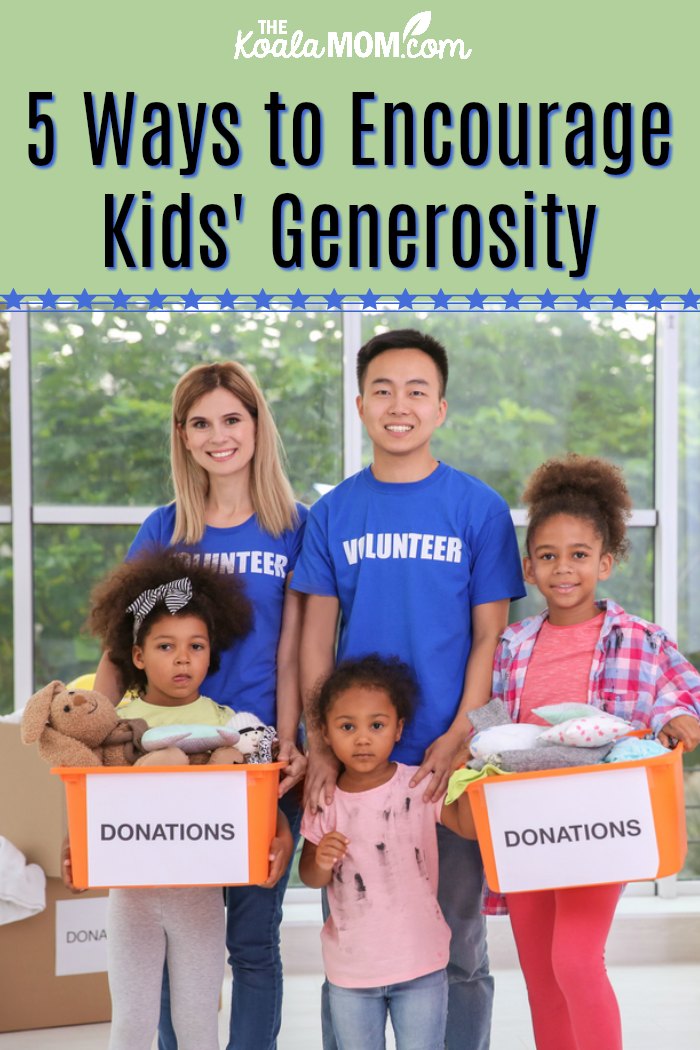For the past week, I’ve had to listen to my 8-year-old’s requests to stop at the dollar store for a particular item she wants. It’s a small item and she has a few loonies to pay for it herself, but I keep putting her off. You see, she’s grown accustomed to getting what she wants as soon as she wants it—and she wants a lot. That’s why I’ve been looking for ways to encourage kids generosity. Instead of rushing out to get the next thing they want, I hope they’ll start thinking about those who are less fortunate than they are.
Here are 5 ideas I’ve come up with to encourage kids generosity. (I’d love to hear your ideas!)

![]()
This is a sponsored post brought to you by Canadian egg farmers, who are proud who support school breakfast programs.
1—Pack Hygiene Kits for the Homeless
There are several corners we drive past on a regular basis where homeless people hang out and ask for change. As soon as my girls notice them, the questions follow. Without bringing up issues like drugs, I try to explain that these people are having a hard time and need some help right now.
When one of the moms at my mom’s group suggested packing hygiene kits for the homeless, we jumped in to help. The girls had fun distributing socks, combs, toothpaste, etc. between the bags. We gave the bags to the local priest, who will hand them out to those who come to him for help.
I also did this at a Vancouver shelter with some other bloggers during Roam ’16. If you want to do it with your kids, I suggest contacting a local homeless shelter to see how you can help. Most of the items required can be picked up at a dollar store. (You could take this activity further by doing some family activities that make money to buy these items!)

2—Visit a Senior’s Home
This summer when we returned to Alberta, I took Sunshine’s violin. I knew many of our relatives would want to hear her play. I also wanted her to play for my 90-year-old grandma, who is currently in a care home.
When we mentioned the idea to staff, they quickly assembled residents in the dining room for the impromptu “concert.” My brother held Sunshine’s book for her. One resident wandered over to examine Sunshine’s violin, saying that she used to play too.

While Sunshine nervously began her piece, I watched the residents, especially my grandma. All of them have dementia or similar reasons for being in care. My grandma barely talks now and has a limited attention span, but her eyes were fixed on Sunshine and a little smile played across her face.
Whatever your child’s talent, visiting a senior’s home is a chance for them to show off and delight someone. Last Christmas, we joined some other homeschoolers to do a little concert for another senior’s home. If your child is nervous about performing alone (as Sunshine was this time), gather another family and go as a group.
3—Donate Unused Toys and Clothes
The changing of seasons is a good time to take stock of kids’ clothes and toys. Often I notice things the girls haven’t used or played with since last summer or fall. While my habit of donating things sometimes causes a hullabaloo with the girls (“you gave away my favourite stuffie!”), it’s also become a chance to talk about “stuff.” We have a lot of stuff; other people don’t.
Sometimes, we give specific things to specific friends who can use it. Other times, we take it to a local thrift store, where it can benefit both the person who is able to buy it for a cheap price and the charity the thrift store supports. When I encourage kids generosity, I’m often surprised by how they respond and what they are willing to give to someone else who needs it.

Set the example for your kids by going through your own closets! If you have unused professional attire, you can donate them to Moore’s annual Canadian Suit Drive every July. If your kids have never seen you wear a certain dress or suit, it’s easy to show them that it can go to a new home now. Take them with you to drop the garments off at Moore’s. Then ask them if there’s anything in their closets they don’t want anymore.
4—Run, Walk or Ride for a Cause
Summer is a great time for races, relays, and marathons. These can be a chance for your little one to raise money for their favourite charity. Many events offer shorter races for kids. The whole family could participate in a longer race, with younger children in a stroller or trailer.
Last weekend, my older two girls biked 10-km without complaining. Lily (age 6) has just learned to ride a two-wheeler. Challenge kids to go further than they think they can or to train for an event like this if they want to participate. They can ask friends and family to sponsor them.
For inspiration, check out 10-year-old Cassie’s story. She and her family just participated in the Scotiabank Vancouver 5 km race this spring to raise money for juvenile arthritis, which Cassie has.
5—Grow and Donate Hair for Wigs
This is a long-term project, as growing hair can take up to a year or more, depending on your child’s hair. If you know someone who has lost their hair to cancer or another disease, this can be a practical way your kids can do something (whether or not the wig is for their friend).
Because they’ll have to work on this for a while, donating hair will encourage kids generosity by reminding them daily about someone else. Your child will have to take care of his or her hair for the person who’s receiving the wig. It’s also a daily reminder of what they have (and often take for granted) that someone else does not.
To find out more about donating hair for cancer, visit the Canadian Cancer Society website or Wigs for Kids BC.
How do you encourage kids generosity? Have your children done activities like this?

No Responses Yet